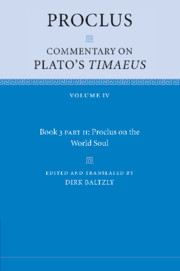VI - The Soul’s Powers, Tim. 36c6–d7
Published online by Cambridge University Press: 30 June 2022
Summary
The soul's powers, Tim. 36c6–d7
He made the circle of the Same revolve horizontally towards the right, but the circle of the Different along a diagonal toward theleft. (Tim. 36c6–8)
The different powers of the two circles
General interpretation
Since it remains to discuss the powers of the soul, the dialogue goes into these matters and deals with the Demiurgic differentiation of them from one another, for the power (dynamis) comes after the essence (ousia), while the activity (energeia) has third place, as we said earlier [125.12– 22]. Plato has also shown this to be so, calling it the rotation (Tim. 36c4) of the Same and the rotation of the Different, but not the essence of these things. He produces various powers from these two circles, and subsequent to this communicates to us what sort of activities they have. He has done the same kind of thing in the Phaedrus when he spoke about the horses, the better one and the worse one.
Well then, what does he say here about the powers of the World Soul? First, as we said, he divides the universal powers into two – I mean the power of the Same and the power of the Different, the one being analogous to the Limited, the other to the Unlimited. Next he divides [the circle of] the Different in accordance with other distinc tive properties and takes it into smaller numbers and unifies the plurality through Sameness. After this he allocates the superior and more divine things to the superior powers, but the things that are further deteriorated to the inferior powers. So to take an example, if you will, the movement to the right has been allocated to the circle of the Same, but movement to the left to the circle of the Different. Also, one gets to move horizontally, while the other gets movement along the diagonal. Furthermore, in the table of opposites, the series that includes the Same, the Right, the Square, and the Rational [number] (to rhêton) has been assigned to the superior member, while the remaining one similarly gets their opposites: the Different, the Left, the Oblong, and the Irrational. So the general intention behind the text at hand is something like this.
- Type
- Chapter
- Information
- Proclus: Commentary on Plato’s Timaeus Volume 4: Book 3, Part 2: Proclus on the World Soul , pp. 245 - 272Publisher: Cambridge University PressPrint publication year: 2009



